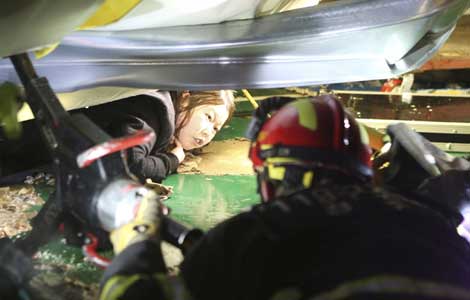Spirit of adventure lives on in Antarctic
Updated: 2014-02-19 01:44
By Zhang Lei and Dong Fangyu in Beijing (China Daily)
|
||||||||
A different reality
Life in Antarctica is not at all how the uninitiated perceive this icebound land, imagining perhaps a carpet of glistening snow covering the hillsides and reflecting the crystal-clear blue skies, and female penguins diving into the freezing water, bringing back food for their partners and offspring. To people with a poetic vision, Antarctica is a continuation of the natural life, but to those on expeditions, the reality is vastly different.
Cui Xiangbin, a glaciology researcher with the Polar Research Institute of China, stayed at Kunlun Station as a member of China's 28th Antarctic exploration team in 2012. His project was to study the dynamics of the ice sheet by exploring subglacial topography and internal layers via ice-penetrating radar.
At an altitude of 4,093 meters, Kunlun is China's highest Antarctic research establishment, Cui said, as he explained the difficulties inherent in traveling between the stations.
To get to Kunlun Station, for example, his team had to leave Zhongshan Station on the coast and travel 1,300 kilometers in caterpillar-tracked vehicles for more than 20 days.
"Although we carried tons of supplies with us on sleds and snowmobiles, we were still badly in need of drinking water and vegetables," he said. "It took a huge amount of time and energy to melt the ice and sterilize it."
However, the difficulties experienced at inland Antarctica research stations during the summer season are nothing when compared to the rigors faced by "winter-over" teams, especially because they had to undergo nearly two months without sunlight, said Cui.
In such an unforgiving environment, team members are likely to develop "winter-over syndrome," which can involve depression, irritability, insomnia, anger, and a variety of behavioral and medical disorders.
Qu said that once Taishan Station becomes fully operational, the researchers will be able to store enough fuel and supplies to allow them to fully recharge their batteries when they return from Kunlun Station, and will also greatly reduce the loads carried by the tracked vehicles.
‘I love you'
The research team has nicknamed Taishan Station "520", because it's 520 km from Zhongshan Station, and in Chinese, "520" is phonetically similar to "I love you."
Among the advantages Taishan Station enjoys are an ice runway for fixed-wing aircraft and the 400-metric-ton inland transport vehicles and equipment with which the establishment has been fitted, helping to provide logistical support for Kunlun station.
"The purchase of fixed-wing aircraft is currently under way. The use of aircraft will greatly improve the efficiency of cargo transport between the four stations (the others are Zhongshan, the Great Wall and Kunlun), particularly in dealing with illnesses, injuries and other unpredictable circumstances. If sensor devices are installed, the aircraft can carry out a wider range of air monitoring," he said.
Currently the only way the team can travel between the stations is by a snowmobile, which resembles a tank. Instead of wheels, it has large caterpillar tracks which allow it to climb steep, snow-covered hills, but on the downside, its top speed is a mere 30 km per hour, meaning it takes a month to ferry materials and necessities from Zhongshan Station to Kunlun Station.
Fixed-wing aircraft are expected to begin missions in 2015. Once it becomes easier to transport supplies to Kunlun, the station will be upgraded to an all-year research establishment, and Taishan's role will be expanded to include that of a training base.
The lantern-shaped architecture at Taishan Station is supported by eight cylindrical bars, and, according to the designer, chief engineer Wang Zhongjun, the exterior design combines elements from science fiction that make it look like a UFO. However, the design wasn't predicated on appearance alone.
"Buildings in Antarctica cause disturbances in the wind field. Strong winds will bring snow that will cover the station and although the annual snowfall around Taishan Station is only two or three centimeters, even large buildings can easily be buried in just two years. Moreover, because there is no spring thaw in Antarctica, the snow will also accumulate to the point where its weight will crush or deform the station," Wang said.
To solve this problem, the main body of the station is built around a streamlined design, while the entire building is set on stilts 2 meters above the ground, not only to improve wind resistance, but also to help blow away the snow near the building.

 Spirit of adventure lives on in Antarctic
Spirit of adventure lives on in Antarctic
 Prince Charles dances in traditional Saudi dress
Prince Charles dances in traditional Saudi dress
 Maglev trains speeding toward greener future
Maglev trains speeding toward greener future
 Building collapse at Korean resort kills 10
Building collapse at Korean resort kills 10
 The big ballet stage
The big ballet stage
 17 more cement plants biting the dust
17 more cement plants biting the dust
 World's largest freshwater lake frozen
World's largest freshwater lake frozen
 American photographer wins World Press Photo 2013
American photographer wins World Press Photo 2013
Most Viewed
Editor's Picks

|

|

|

|

|

|
Today's Top News
Reforms to put safety first for low-level flights
PLA soldiers bigger, need new gear
China's aviation school banks on global ties
Green timber preferred overseas but not locally
NHK head regrets history words
Police to root out organizers of prostitution
Li to officials: Move ahead with improvements
'Equal' talks open to Taipei
US Weekly

|

|





